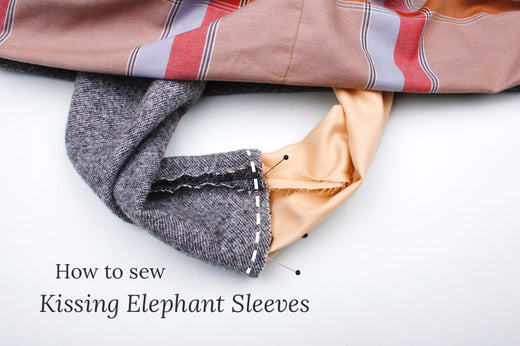We often receive questions about fabric choices for sewing Twig + Tale Vest and Coat patterns. While wool blankets are certainly warm and cosy, they can be difficult to come by in many parts of the world. Here are some ideas for non-wool fabrics that work beautifully for sewing vests and coats.

Fabric Types
Depending on the season, vests and coats can be made in a wide variety of fabrics. Twig + Tale coat and vest patterns are fully lined, so they will require an outer fabric, as well as a lining fabric. This opens up plenty of scope for inspiring fabric combinations.
For warm-weather wear or layering pieces, look for lightweight fabrics in breathable natural fibres. Linen and hemp offer a beautiful, rustic-looking texture. Quilting cotton and cotton poplin are available in a wide array of colours and patterns. Cotton lawn makes a fine, almost silky-feeling lining. Pictured below is a Pathfinder Vest with a cotton gauze outer and cotton lawn lining, making a stunning and versatile light layering piece.

For cooler-weather garments, denim, canvas, and cotton duck are good choices for sturdy outerwear. Corduroy, velveteen, and brushed twill are softer options that would still hold up well. Flannel makes a cuddly, soft lining fabric.
Using quilted fabric for either the outer or inner fabric is a good way to add some extra warmth to a garment. Pre-quilted fabrics, including cotton, nylon, or jersey knit, are often available in fabric stores. Or, you can customize a garment by making quilted fabric yourself - it takes a bit of extra time, but the results are so worth it.
Interested in giving it a try? Have a look at this post for some tips, or this post if you're looking for inspiration. The Trailblazer Vest pictured below was made with quilting cotton, sherpa, and a thick layer of batting for extra insulation. So cosy!

For a natural fibre water-resistant fabric, have a look at laminate cotton or oilskin. Pictured below is an oilskin Trailblazer Vest, lined with cotton gingham, and an added layer of quilt batting for extra insulation. If you're interested in making your own waterproof fabric, we've got resources to help - click here to read about how to wax your own fabric. The wax can be re-applied when the fabric starts to lose it's waterproofness, making it a sustainable, long-wearing option.

Corduroy is readily available and makes lovely outerwear. It has a soft, velvety-feeling surface and comes in a variety of weights.
If you are unfamiliar with corduroy, here are some examples of different types. The fabric pictured below left is quite thick and plushy, and is described as wide-wale or 8-wale corduroy. In the middle is a medium-wale corduroy, 14-wale. On the right is a fine-wale needlecord (also known as baby cord), which is 22-wale.

It is possible to use knit fabric for vests or coats, although we'd recommend sticking with stable knits that don't have too much stretch. French terry, cotton fleece, and sherpa are all lovely choices that feel soft and cosy.
Polar fleece and softshell are also lightweight, warm options, though we tend to favour natural fibres for breathability, fabric longevity, and environmental impact. Pictured below is cotton fleece Pathfinder Vest with quilting cotton lining.


Upcycling Ideas
Corduroy, denim, or twill trousers or skirts are all wonderful choices for upcycling into vests or coats. Some creative seaming may be necessary to get enough yardage, or multiple fabrics can be combined for a colour-blocked effect. Re-using the pockets can add a unique detail too.

Though we're focusing on non-wool ideas, repurposing holey wool sweaters is a wonderful way to upcycle. Felting the sweater before using it has a number of benefits: the fabric is denser and warmer, it is less likely to unravel when cutting, and it won't stretch as much. This is a lovely way to use a sweater with some holes that can be worked around - an adult sweater can yield enough felted fabric for a baby sweater, like the sweet little Baby Pathfinder, lined with soft corduroy, pictured below.

Shirts are ideal for vest and coat linings. Flannel, cotton shirting, chambray, and linen would all make a beautiful lining, and an adult shirt often yields plenty of fabric for a child's garment. Using a natural-fibre fabric for the lining makes it breathable and soft. Also look out for skirts and dresses, which can also provide plenty of yardage to work with.

Really, the sky is the limit when it comes to upcycling ideas for coats and vests. In a search for sturdy, warm fabric, our pattern testers have upcycled all manner of fabric including leather jackets, sleeping bags, and even a canvas tent (pictured below). We love seeing your creative re-use of materials!


What fabric do you use to sew vests and coats? We'd love to hear your ideas! Please join us at the Twig + Tale Chat Facebook group to share your beautiful projects.
~Lovely images by Angela Schade, Kiran Grewal, Lisa Spearman, Kel Curteis, Jocelyn Buggie, and Rachel Osterday ~




